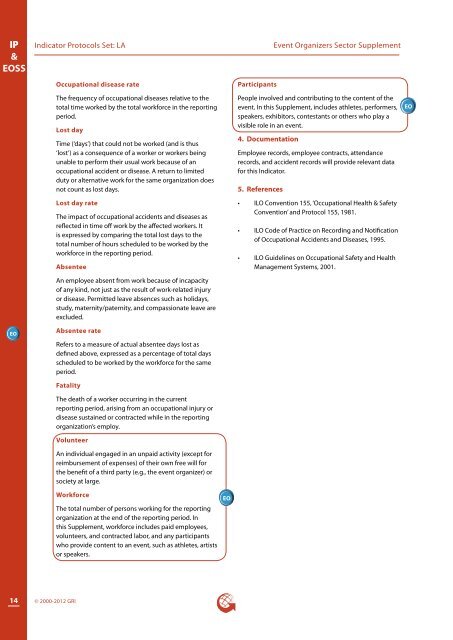Event Organizers Sector Supplement - Global Reporting Initiative
Event Organizers Sector Supplement - Global Reporting Initiative
Event Organizers Sector Supplement - Global Reporting Initiative
You also want an ePaper? Increase the reach of your titles
YUMPU automatically turns print PDFs into web optimized ePapers that Google loves.
IP<br />
&<br />
EOSS<br />
Indicator Protocols Set: LA<br />
Occupational disease rate<br />
Participants<br />
<strong>Event</strong> <strong>Organizers</strong> <strong>Sector</strong> <strong>Supplement</strong><br />
The frequency of occupational diseases relative to the<br />
total time worked by the total workforce in the reporting<br />
period.<br />
Lost day<br />
Time (‘days’) that could not be worked (and is thus<br />
‘lost’) as a consequence of a worker or workers being<br />
unable to perform their usual work because of an<br />
occupational accident or disease. A return to limited<br />
duty or alternative work for the same organization does<br />
not count as lost days.<br />
Lost day rate<br />
The impact of occupational accidents and diseases as<br />
reflected in time off work by the affected workers. It<br />
is expressed by comparing the total lost days to the<br />
total number of hours scheduled to be worked by the<br />
workforce in the reporting period.<br />
Absentee<br />
An employee absent from work because of incapacity<br />
of any kind, not just as the result of work-related injury<br />
or disease. Permitted leave absences such as holidays,<br />
study, maternity/paternity, and compassionate leave are<br />
excluded.<br />
People involved and contributing to the content of the<br />
event. In this <strong>Supplement</strong>, includes athletes, performers,<br />
speakers, exhibitors, contestants or others who play a<br />
visible role in an event.<br />
4. Documentation<br />
Employee records, employee contracts, attendance<br />
records, and accident records will provide relevant data<br />
for this Indicator.<br />
5. References<br />
• ILO Convention 155, ‘Occupational Health & Safety<br />
Convention’ and Protocol 155, 1981.<br />
• ILO Code of Practice on Recording and Notification<br />
of Occupational Accidents and Diseases, 1995.<br />
• ILO Guidelines on Occupational Safety and Health<br />
Management Systems, 2001.<br />
EO<br />
EO<br />
Absentee rate<br />
Refers to a measure of actual absentee days lost as<br />
defined above, expressed as a percentage of total days<br />
scheduled to be worked by the workforce for the same<br />
period.<br />
Fatality<br />
The death of a worker occurring in the current<br />
reporting period, arising from an occupational injury or<br />
disease sustained or contracted while in the reporting<br />
organization’s employ.<br />
Volunteer<br />
An individual engaged in an unpaid activity (except for<br />
reimbursement of expenses) of their own free will for<br />
the benefit of a third party (e.g., the event organizer) or<br />
society at large.<br />
Workforce<br />
The total number of persons working for the reporting<br />
organization at the end of the reporting period. In<br />
this <strong>Supplement</strong>, workforce includes paid employees,<br />
volunteers, and contracted labor, and any participants<br />
who provide content to an event, such as athletes, artists<br />
or speakers.<br />
EO<br />
14<br />
© 2000-2012 GRI

















